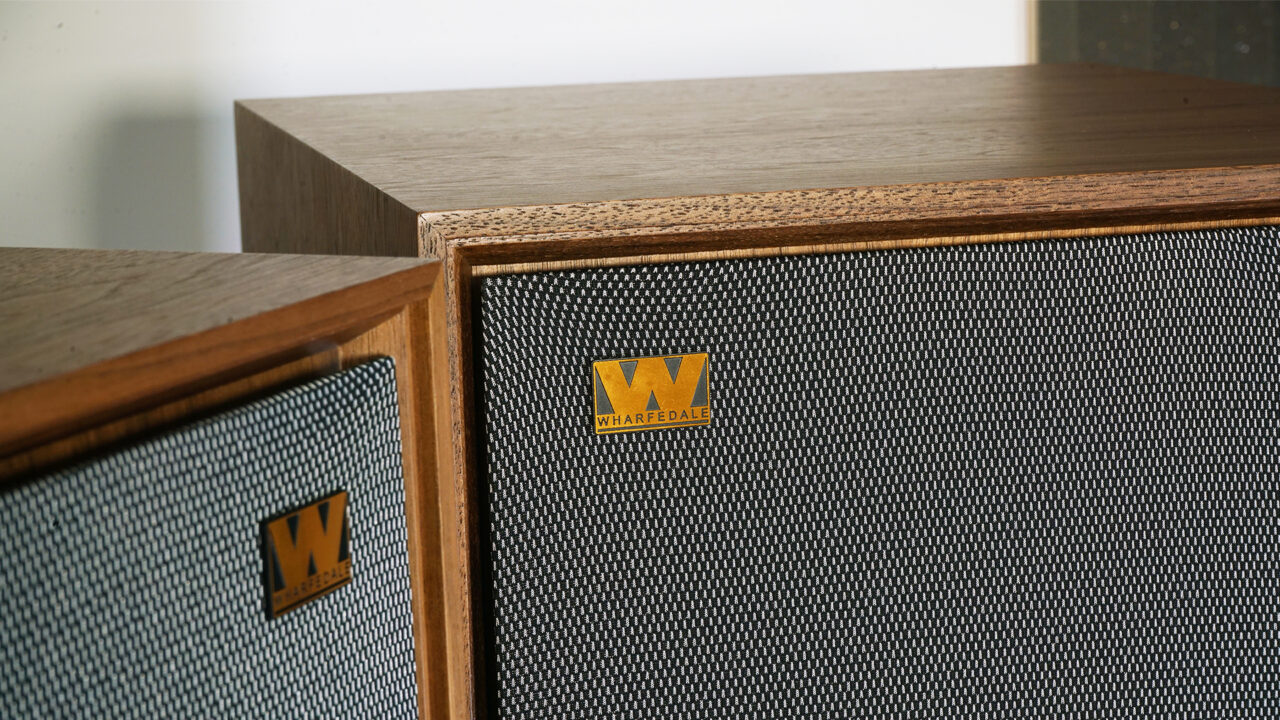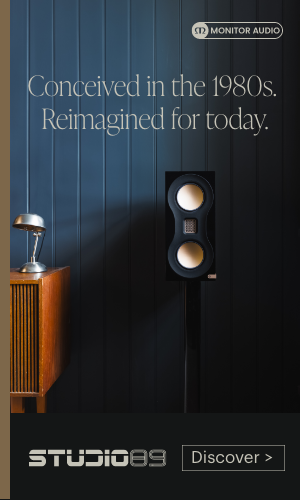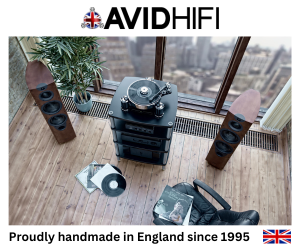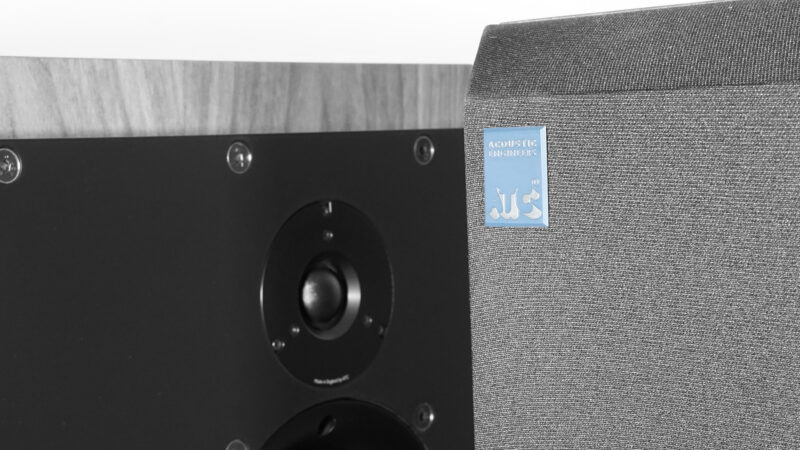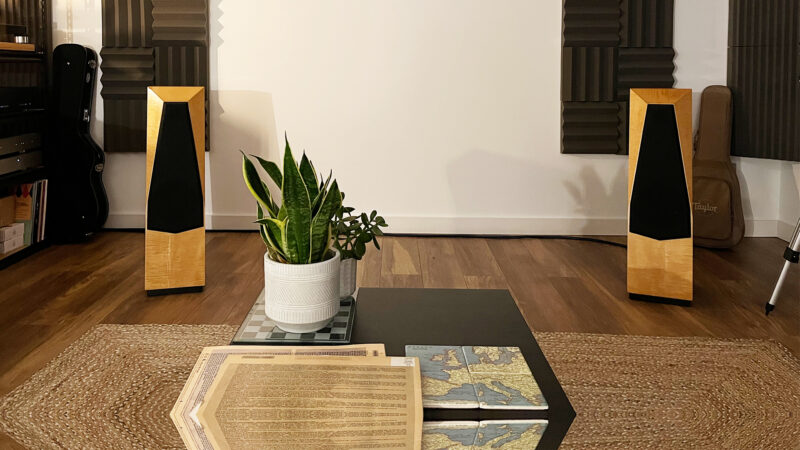Few loudspeakers, or hifi products in general for that matter, have garnered as much online anticipation and chatter as Wharfedale’s recently revitalised Dovedale since its release.
Why? Because if there is such a thing as the hifi zeitgeist, the Dovedale not only captured it, but treated it to a weekend away with all the stops pulled out. In case you haven’t noticed retro is back, with many brands celebrating their models past with ‘reimagined’ modern iterations. And it’s easy to see the appeal, with customers hankering for kit that takes them down memory lane to their music listening glory days, while offering the performance we expect from today’s hifi (epitomised by Linn’s LP12).
Thankfully for Whardedale this is an easier ask than it is for most brands, because it’s got one of the richest back catalogues in hifi history.
Watch our in-depth interview with Wharfedale and Director of Acoustic Design at IAG, Peter Comeau
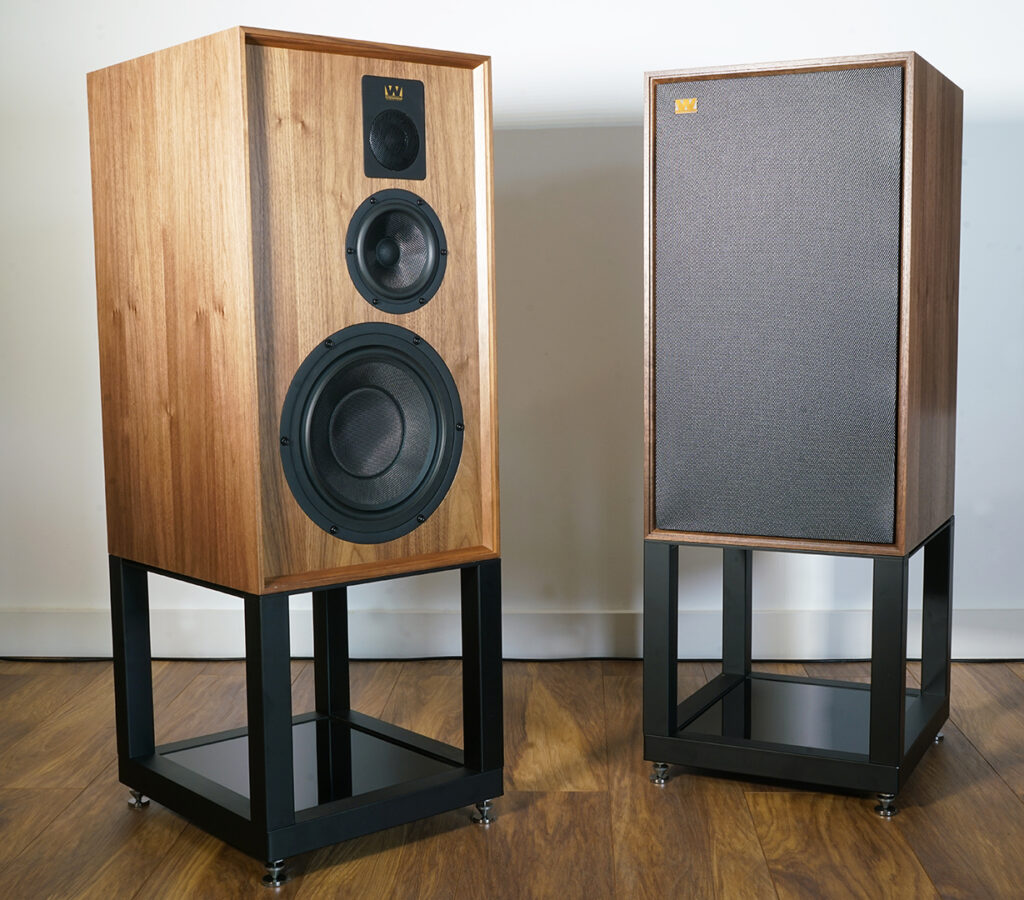
Resplendent in real walnut wood finish (including on its front baffle), the Dovedale looks just as good with its dedicated recessed covers on or off
From the Peaks
Named after one of the most beautiful valleys in the UK, the original Dovedale model stretches right back to 1959, with improvements along the way which took it to Dovedale 3 status in 1971 (which the new model takes most of its inspiration from), before it was eventually retired (there was also a Unit 5 kit which ran from 1970 to 1973 ,when it then became the Dovedale 3 kit until 1977).
A large standmout three-way design, the originals screamed ’70s hifi with the final iteration boasting a whopping 12″ bass driver in a wood panelled cabinet with recessed grille that was true to the times.
Fast forward fifty years and the Dovedale 3’s spirit is very much alive and well in this new model, also being a large three-way standmount that’s clad in gorgeous walnut wood.
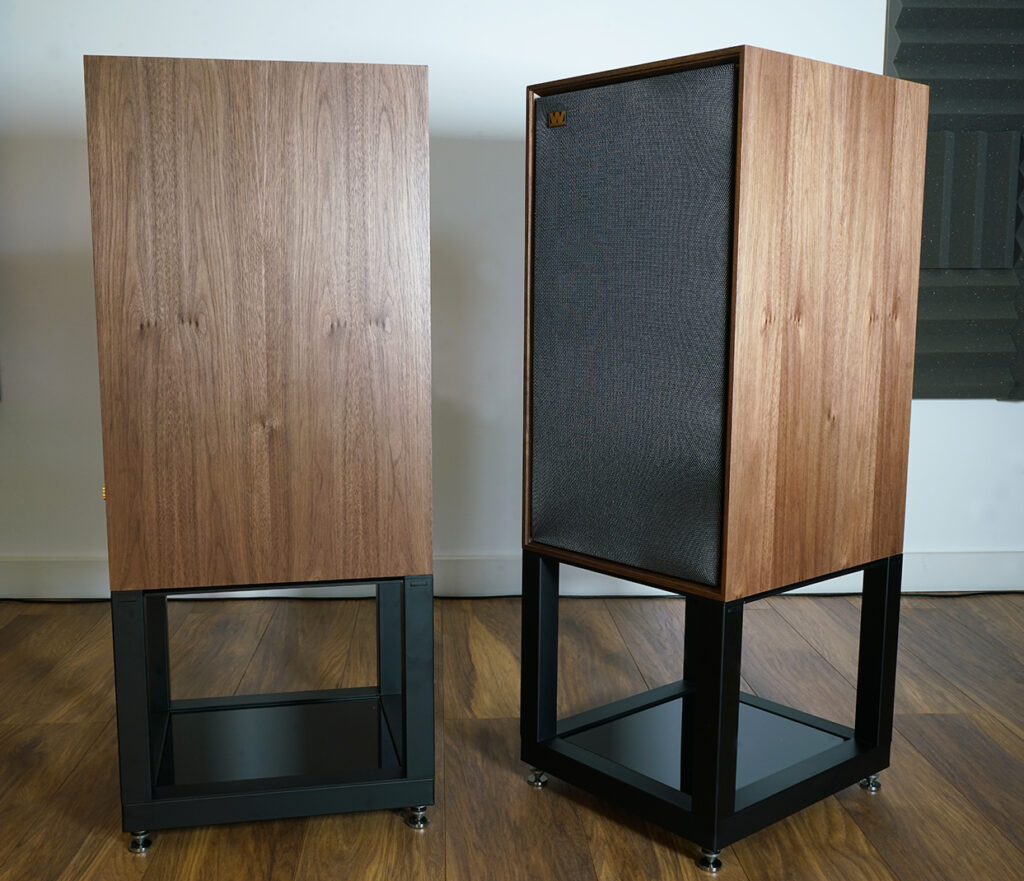
Measuring (WDH) 370 x 417 x 660mm (1023mm high with stands), the Dovedale is a big, bold audio statement that is cool enough to outclass most folks’ furniture
While taking its ancestral heritage from its vintage namesake, the new Dovedale inevitably invites comparisons to Wharfedale’s current Heritage Series Linton stablemate, which at a glance bears some similarities, both being wide baffled three-way standmount designs. And in many ways this is the Dovedale’s biggest problem, because the Linton is so competitively priced at £1,249, compared to the Dovedale at £5,500 (with stands).
In fairness though I never understood why (and how) Wharfedale priced the Linton so cheap (an utterance I’ve rarely used in hifi about any product), and the Dovedale is a much more developed concept, especially in its cabinet design and crossover.
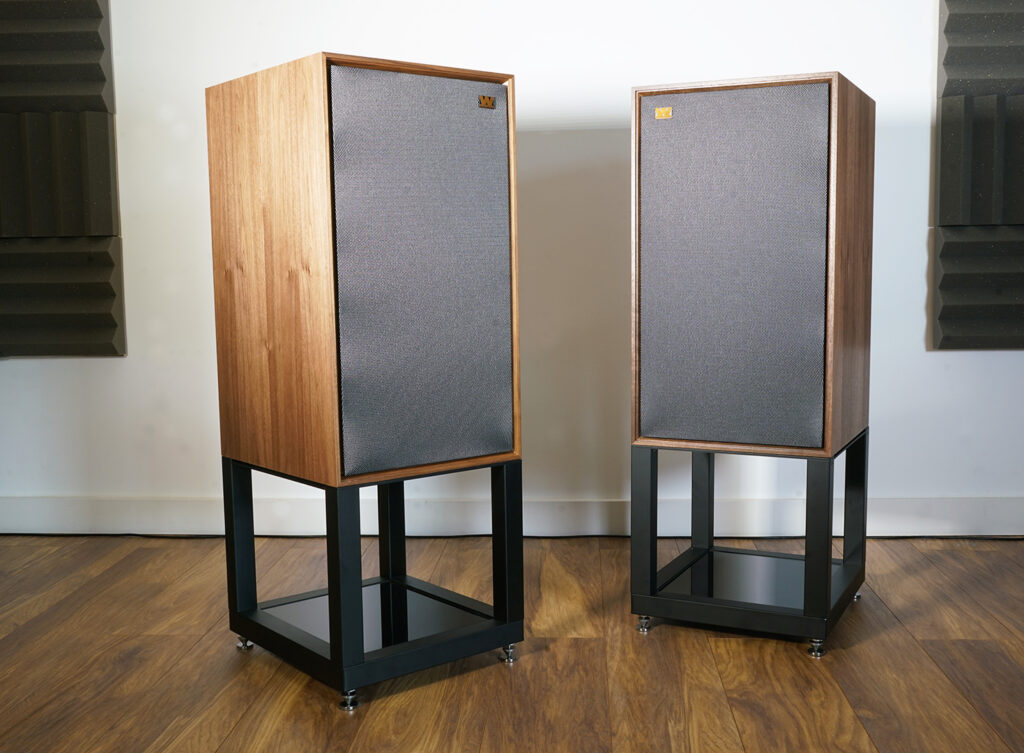
Retro yet modern, unlike most modern speakers, the Dovedale is designed to sound at its best with covers on
Like most loudspeakers which rely on a similar family of drive units (an obvious comparison being Dynaudio, which at a glance uses similar looking drive units across models spanning a few hundred quid to well into five figures), the extra cost is in how those drive units are refined and incorporated into more developed cabinets, for greater performance.
Call a cab
And its the cabinet that signifies how much Wharfedale has poured into the Dovedale’s design to get the best from it. Clad in gorgeous satin finished book matched walnut wood veneer, the cabinet walls are an 18mm sandwich construction (aside from the front baffle, which is 25mm thick), with 6mm thick MDF forming the outer layer and 12mm thick high-density particle board for the inner, bonded together with high-damping glue.
Alongside internal bracing there is also extensive internal damping, affording each drive unit its own internal chamber to work within, minimising internal cabinet resonance and reflections.
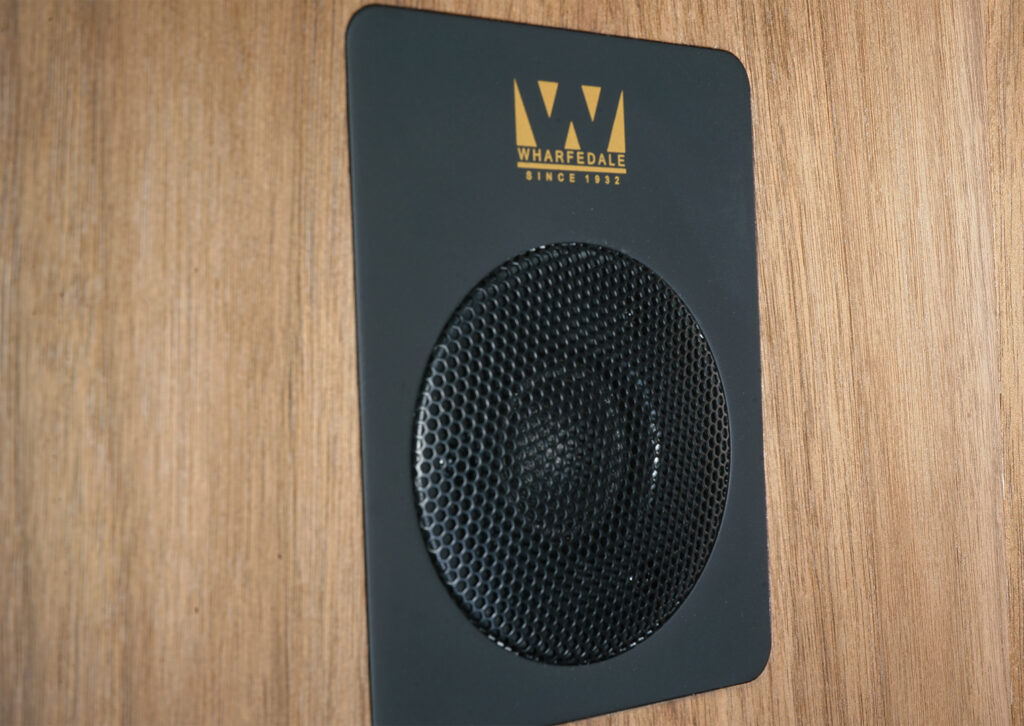
25mm soft dome Tweeter is protected behind a fixed mesh grille, with retro branding to match
The Dovedale’s tweeter is based on the same 25mm (1″) fabric-dome that’s been central to the heritage range, with a ferrite (ceramic) magnet instead of neodymium as many manufacturers favour. For the Dovedale though it’s been treated to a much larger dedicated rear enclosure with its own tuned damping, to absorb more of the rear diaphragm’s sound for greater dynamics and detail.
On midrange duties beats a full 5″ Kevlar woofer, which crosses over at 560Hz to the bass driver and at 2.9kHz to the tweeter. Being so large (5″ is considered bass driver proportions in many standmount speaker designs) ensures it’s less stressed than most, and can in fact reach down to 120Hz, so it’s able to operate across a much wider frequency range for more seamless integration with its partnering tweeter and bass driver.

The Dovedale’s 135mm (5″) midrange driver is formed from woven Kevlar, adding a modern twist to the speaker’s vintage vibe
The midrange driver’s rear chamber is also key to its performance and because the cabinet is over 400mm deep, it gets a full 8.6L of dedicated acoustically damped space to operate within (which is closer to transmission line proportions than bass reflex designs).
No stress
And for bass duties the hardware goes up another notch, thanks to a no-nonsense dedicated 10″ woven Kevlar woofer with inverted roll surround and dust cap. By modern standards, where loudspeakers are much more efficient than their forefathers (partly seeding the move to smaller drive units), this is massive and comes fixed in a rigid die-cast chassis with large diameter voice coil at its rear.
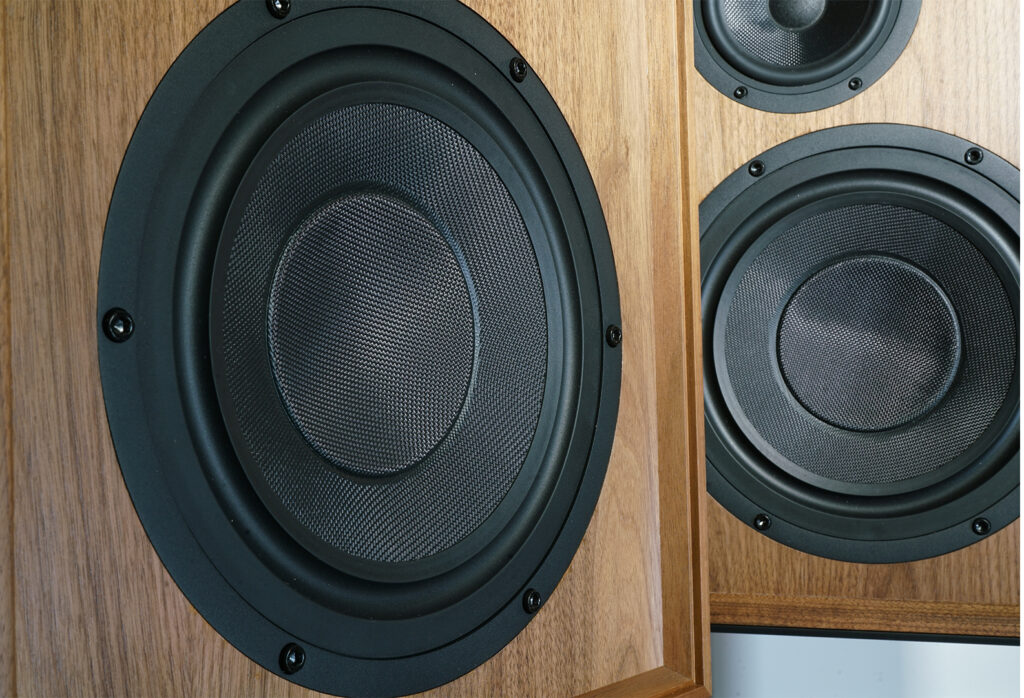
Put that sub away! Ample 10″ (250mm) bass driver made from woven Kevlar is unique to the Dovedale and can more than hold its own on low frequency duties
Having a bass driver on this scale means it needs to work less hard to shift the same amount of air as smaller bass drivers by comparison, hence on all but the most demanding material it’s likely to be operating well within its comfort zone. Think of it like a beefcake down the gym, at ease lifting small weights.
In a break from the original models, this updated Dovedale is a rear ported (rather than sealed cabinet) design, which combined with the large bass driver’s performance and cabinet size, has allowed Wharfedale to tune the cabinet’s output all the way down to 25Hz, while at the same time reducing back pressure on the woofer.
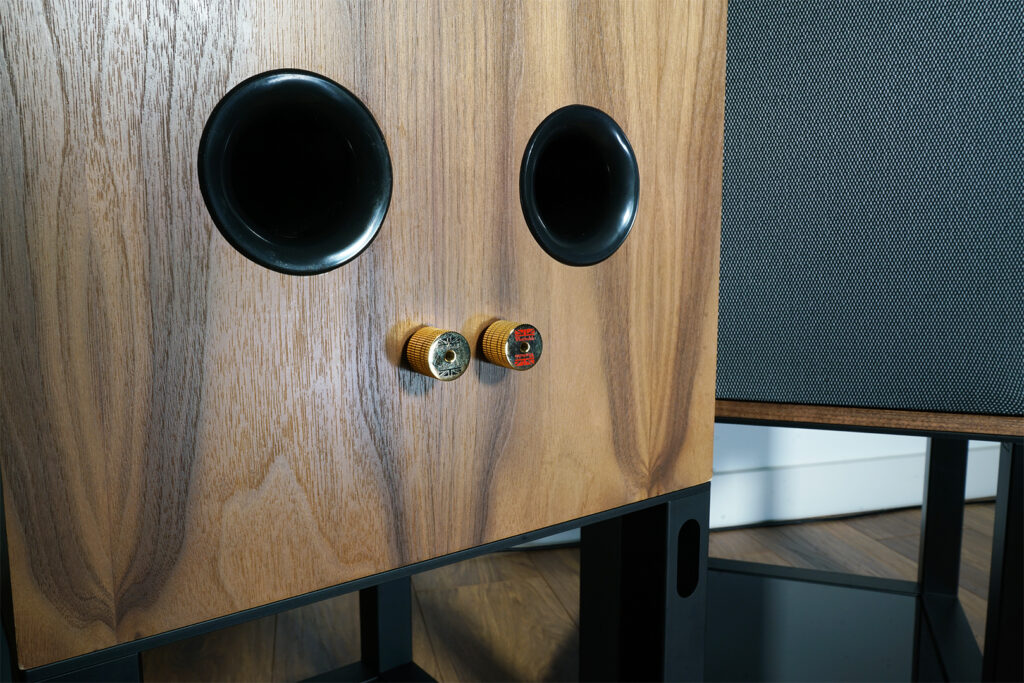
Twin rear ports are there for cabinet tuning. Chunky gold plated speaker terminals offer single connections only
A multi-driver speaker’s performance can only ever be as good as its crossover, and for the Dovedale this has also had special attention paid to it. Separate PCBs (one for the tweeter/midrange circuits and one for bass) are the order of the day, to minimise electromagnetic interference (EMI).
Polypropylene film capacitors are used throughout and large coils (ie air core types) have been eschewed, again in a bid to keep EMI and resistance down, presenting a more friendly amplifier load in the case of the latter, leading to 89dB sensitivity and a nominal 6 ohm impedance.
Back to Blighty
And it’s not just what’s gone into the Dovedale, but where, as unlike the rest of Wharfedale’s offerings which are assembled in parent company IAG’s factory in China, the Dovedale is built back at base in Wharfedale’s Huntingdon UK HQ within a recently developed 9,000ft² production facility (which includes a dedicated anechoic chamber for critical listening).
Sure the drive units are made over in China as are the crossover componets, and why wouldn’t they be? Given the scale of facilities IAG has on tap over there, however the Dovedale’s cabinet, complete assembly (including the crossovers and internal cabling), finishing and tested takes place back in Huntingdon, allowing them to exceed the official ‘Made in Britain’ accreditation (even the packaging is UK sourced). And in my opinion any hifi brand that is looking to relocate its manufacturing back to the UK should be applauded.
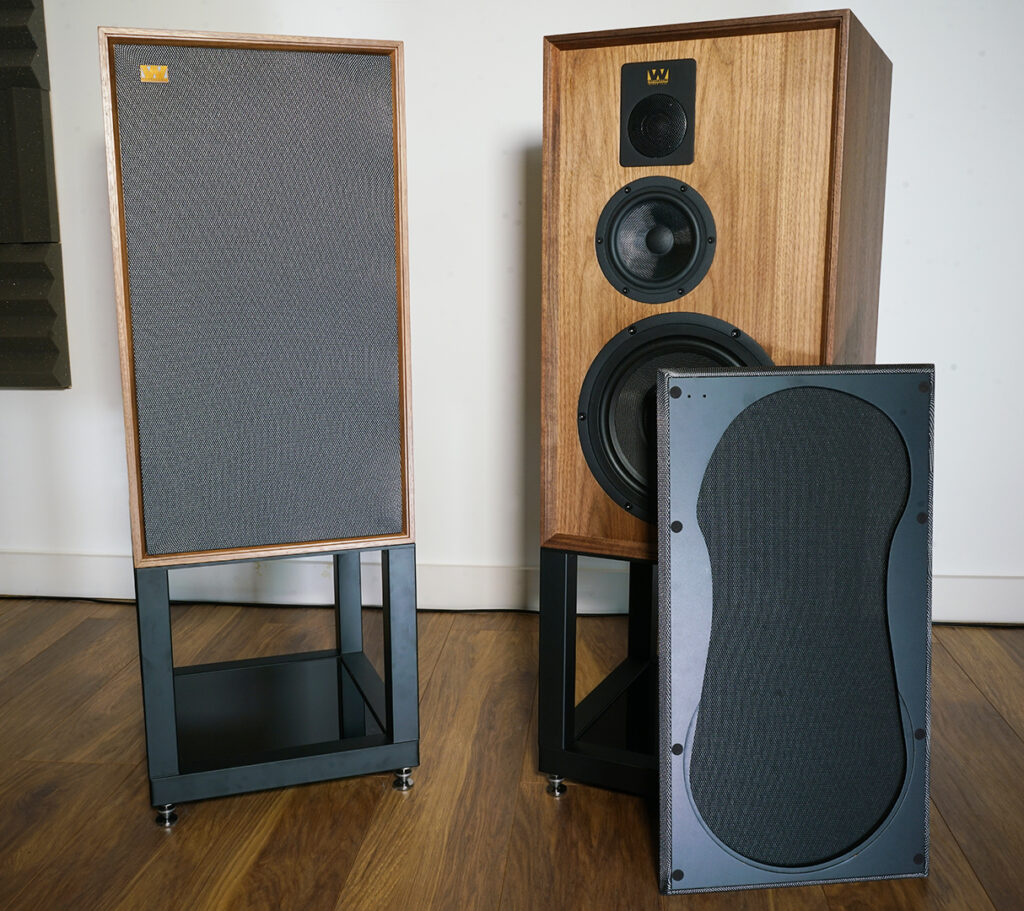
Covers are held in place using hidden magnets, note how their fabric’s weave has a quilted look when the light catches it, adding to their vintage charm
Performance
While opting for the dedicated stands adds to the bill, for a speaker in this class it’s a worthwhile inclusion as they’re perfectly sized and well made with quality spikes and cups, so you know you’re hearing the Dovedales as their designers intended. The stands arrive flat packed though, so you’ll need 10 minutes on the spanners to pop them together, but it’s easy enough.
Critical listening was carried out with the front covers in place as Wharfedale stipulates, as the grilles aren’t just cosmetic and help reduce cabinet reflections from the edges that overhang the front baffle.
Partnering gear is a Rotel Michi X5 amp and turntables by VPI and SME with AVID’s top flight tonearm in the mix, alongside Primare streaming gear.
I’m approaching this review off the back of spending considerable time with hi-end loudspeakers from Dali (the Epikore 11) and ATC (its SCM100PSL), both of which cost multiples of the Dovedales. However what’s apparent after some months with the Wharfedales (to also ensure they’re fully run in) is how they’re able to hold their own with much more expensive rivals.
The ATC is perhaps the closest in comparison, as it’s also a large three-way standmount with a wide front baffle, although it’s cut from a pro rather than domestic audio cloth with a very different sonic signature. Whereas the ATC excels in its focus, almost ruthlessly so, the Dovedale offers a more fluid and in some ways more musical experience. The fact that it’s able to offer so much (albeit in a different sonic flavour) in comparison to a loudspeaker costing three times as much shows how much Wharfedale has been able to get from the Dovedale’s design – ‘more than the sum of its parts’ is the slogan that springs to mind.
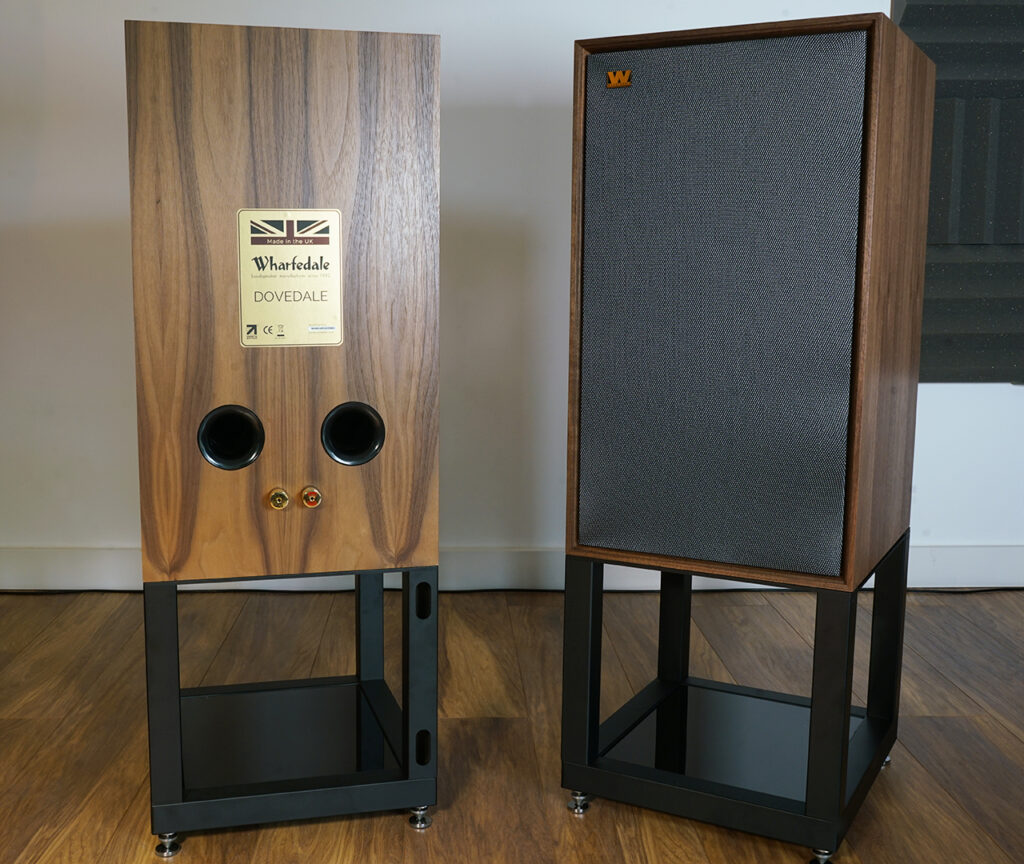
Dedicated stands cost £800 if bought separately, or £500 as part of the package. Note the cable carrying cut outs on the rear leg
What’s it’s not thought is a ’70s looking speaker with a ’70s sounding performance, and if you’re expecting a soft and cosy sonic experience that’s all pipe, slippers and misplaced nostalgia then the Dovedale is here to tell you the times are indeed a-changing. Despite the warm looks, these are dynamic performers that don’t overly favour a particular type of music.
On the Dovedale’s Bess Atwell’s Sylvester (at 16-bit/44kHz via Qobuz from our recent playlist) for example has a fluidity across the midrange and treble that sounds as soothing as it is revealing. And one of the reasons for this is that these are big sounding speakers, capable of filling moderate to large rooms with absolute ease (ours measures 6.8 x 4.8m), which means that treble and midrange really has room to breathe and properly fill the room. Off axis listening is also very impressive, more so than most floorstanders at this price (and height).
Room filling
With the speakers arranged so that their tweeters and midrange drivers are on their inner edges (and grille badges positioned to match, as Wharfedale also stipulates) the music follows you around the room with a tonality that remains consistent across the frequency band, something I’ve found you only really experience with larger and more accomplished loudspeakers, from Wilson and the like.
And then there’s the bass from those 10″ woofers, which not only delivers some of the richest and most deeply textured low notes I’ve heard in some time without a sub or two in play, these low frequencies serve to make the whole soundstage seem more expansive with richer and creamier textures throughout. Matthew Halsall’s An Ever Changing View (24-bit/96kHz) from his album of the same name for example sounds like his orchestra has set up shop in a much grander space than I’m used to, as the bass notes climb and fall from deep within the mix while the trumpet meanders seamlessly across mid and high octaves, without any hint of where the crossover points are.
I’ve read reports of the Dovedale’s treable sounding ‘peaky’ or on the thin side, but this wasn’t borne out in my time with them no matter how I hard I pushed. Spinning a vinyl pressing of Nirvana’s 1993 LP In Utero (partly in tribute to the recent sad passing of its producer Steve Albini) and even with the tone settings matched to the sleeve notes’ recommendations (treble cranked up at five over two in the bass), the Dovedales present the music with convincing degrees of bite and authenticity. On tracks including Very Ape and Radio Friendly Unit Shifter, they have no problem recreating Albini’s raw, abrasive and high pitched fresh from the studio sonic signature that has made this album standout as a benchmark in mainstream success, without mainstream compromises. In fact I wasn’t expecting to enjoy this type of material quite so much on these speakers, but as the saying goes, don’t judge a book by its retro walnut cover.
Serve them something a bit more sophisticated via Muzz’s Summer Love from their self-titled 2020 album at 24-bit/96kHz and you’ll be rewarded with an equally sophisticated sound. The way those bass notes punch the air, contrasting the acoustic guitar’s gentle strums and vocals drenched in reverb demonstrate how these speakers are able to bring out all the nuance in the music with a sense of ease, it’s a testament to just how well articulated they are.
In summary
Wharfedale has hit the mark with the Heritage line and as the flagship model, the Dovedale pushes this sub-brand by some way in both price and performance (and I wouldn’t be the least surprised if more models soon follow, bridging the gap between it and the cheaper models). But what the Dovedale also shows is how far Wharfedale is able to properly push the envelope when the shackles are fully off.
Every aspect has been considered and developed for performance, while not diluting their vintage charm. They’re heritage in name and style, but their performance is anything but. At £5,500 they’re not cheap as Wharfedale’s go, but compared to wide baffled models from many rivals (Spendor and Harbeth to name but two), nor are they disproportionally expensive.
What’s more, their ability to really drive a room (big and small) go beyond many rivals costing this and more, married to a build and charm that’s hard not to fall in love with, making them a sure fire hit.


